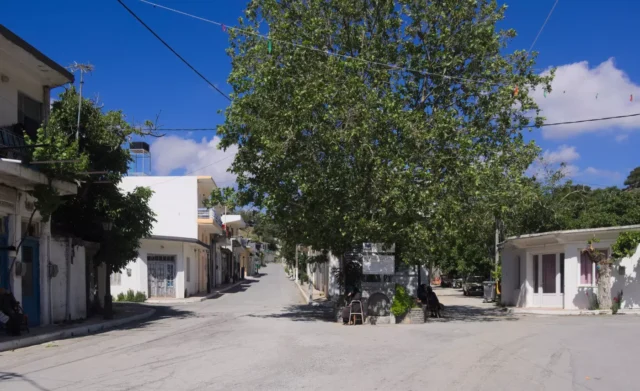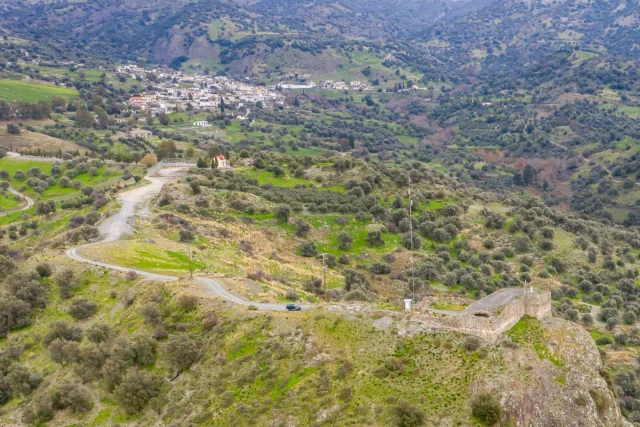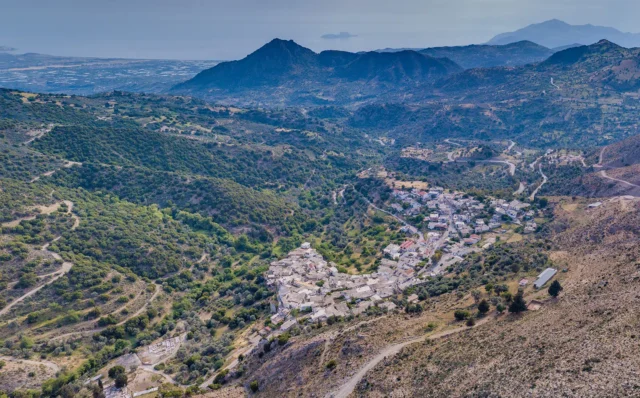829
listings found
Categories
Active filters:
Antiskari, Phaistos
Antiskari is a settlement located in the Heraklion regional unit on the island of Crete, Greece. It belongs to the Municipality of Phaistos

Kalavros, Siteia
Kalavros is a settlement located in the Lasithi regional unit on the island of Crete, Greece. It belongs to the Municipality of Siteia and is 12.6 kilometers away from the […]
Georgioupoli, Apokoronas
A seaside tourist resort in the Apokoronas region of Chania, Crete, located 40 kilometers from Chania and 20 from Rethymno. The village sits on a plain at the estuaries of the Almyros and Perastikos rivers, with the former creating a notable lake biotope. Historically the site of the Roman city of Amphimalla, with evidence of Minoan habitation, the area also saw Venetian and Ottoman fortifications. Originally called Almyroupoli, it was renamed for Prince George. Today it is known for its long sandy beach, a central square with eucalyptus trees, a small harbor, and the iconic whitewashed chapel of Agios Nikolaos at the end of a long sea pier.
Prinias, Gortyna
Prinias is a settlement located in the Heraklion regional unit on the island of Crete, Greece. It belongs to the Municipality of Gortyna
Avrakontes, Lasithi plateau
Avrakontes is a settlement located in the Lasithi regional unit on the island of Crete, Greece. It belongs to the Municipality of Lasithi plateau
Genna, Amari
Genna, in Crete's Amari Municipality, features a rich history from Minoan to Venetian eras. The village houses a Late Minoan III chamber tomb and a Hellenistic-Roman cemetery, linking it to ancient Sybrita. Historical records note Venetian and Ottoman presence, with documented population changes. The area, known for its fertility, includes 14th-century churches with Byzantine frescoes, such as Saint Onoufrios and Saint Stephen. An ancient olive tree, over 2000 years old, stands nearby, reflecting the village's agricultural heritage. The village also has a spring with potable water and a shaded area.
Profitis Ilias, Heraklion
Profitis Ilias, formerly Kanli Kastelli, is a historic village in Heraklion, Crete, at the foot of Rokka hill. Ancient Lykastos' acropolis stood here. The Byzantines built Temenos fortress, later fortified by Venetians (Castello Temene). Ottomans renamed it Kanli Kastelli ("Bloody Fortress"). Known for agricultural production, particularly grapes, raisins, olive oil, and wine, the village has a population of 1,320. It features a Citizens' Service Centre, police station, schools, a medical clinic, and several churches.
Partira, Minoa – Pediada
Partira is a settlement located in the Heraklion regional unit on the island of Crete, Greece. It belongs to the Municipality of Minoa - Pediada
Garipa, Minoa – Pediada
Garipa is a settlement located in the Heraklion regional unit on the island of Crete, Greece. It belongs to the Municipality of Minoa - Pediada
Mesochorio, Archanes – Asterousia
Mesochorio is a settlement located in the Heraklion regional unit on the island of Crete, Greece. It belongs to the Municipality of Archanes - Asterousia
Matala, Phaistos
Located 68 km from Heraklion on Crete's southern coast, this village is famed for its beach and cliffs with carved caves. Historically, it served as the Minoan port for Phaistos and the Roman port for Gortyn. The caves, used as tombs in the Roman and Christian eras, feature rooms and stairs, suggesting they were also dwellings. In the 1960s and 70s, they became a sanctuary for hippies, including Joni Mitchell and Bob Dylan, an era that ended with the Greek military junta.
Magarikari, Phaistos
Magarikari, a historic Cretan village nestled on Mount Psiloritis' foothills, boasts a rich past. First recorded in 1583, it endured Ottoman and WWII hardships, including a devastating Nazi reprisal. Birthplace of resistance hero Petrakogiorgis, Magarikari's history is intertwined with Crete's struggles. Its location offers panoramic views of the Messara Plain. The village thrives on olive cultivation and features several notable churches, reflecting its cultural heritage. Population has grown from 140 in 1583 to 291 in 2011. Today, Magarikari balances tradition with modern life, offering a glimpse into authentic Cretan village life.
Kamares, Phaistos
Kamares, a village nestled in the foothills of Mount Ida, Crete, is historically significant due to its proximity to the Kamares Cave. This cave was a vital Minoan religious center, renowned for the discovery of Kamares Ware pottery, dating back to 2000 BC. The village, at an elevation of 600 meters, offers scenic views and a rich history, attracting tourists interested in Minoan civilization and the nearby Ideon Antro Cave. Its population, around 331 in 2011, engages in agriculture, livestock farming and tourism-related activities. Kamares blends its historical past with modern life, offering visitors a glimpse into Cretan heritage.
Dionysi, Gortyna
Dionysi is a settlement located in the Heraklion regional unit on the island of Crete, Greece. It belongs to the Municipality of Gortyna
Kamariotis, Malevizi
Kamariotis, a Cretan village in Malevizi, Heraklion, at 620m altitude, boasts a rich history dating to the 14th century. Mentioned in 1396 Ducal Archives, its name derives from the first settler "Kamaridis" or "Kamariotis." The village played a role in Crete's struggle for independence, notably the 1867 battle. Architectural landmarks include the 16th-century Church of Saint George with Venetian/Byzantine symbols, and the 14th-century Church of Panagia with frescoes. Trypiti's rock formations, a Turkish fountain, and Kremastos' oak forest add to its charm. Viticulture is a key occupation, and festivals in April, August, and September (tsikoudia festival) celebrate local culture. The village has seen population fluctuations, from 237 inhabitants in 1583 to recent revitalization efforts.
Aidonochori, Malevizi
Aidonochori is a settlement located in the Heraklion regional unit on the island of Crete, Greece. It belongs to the Municipality of Malevizi.
Zoniana, Mylopotamos
Zoniana is a settlement located in the Rethymno regional unit on the island of Crete, Greece. It belongs to the Municipality of Mylopotamos
Perama, Mylopotamos
Perama is a settlement located in the Rethymno regional unit on the island of Crete, Greece. It belongs to the Municipality of Mylopotamos
Kissamos, Kissamos
Kissamos is a settlement located in the Chania regional unit on the island of Crete, Greece. It belongs to the Municipality of Kissamos
Alagni, Archanes – Asterousia
Alagni, a village 25 kilometers from Heraklion, Crete, has a history rooted in the Minoan civilization. The village's name is believed to be derived from the nymph Alagonia, and ruins of a temple dedicated to her are said to be found on Tholi hill. Alagni is near the Minoan palace of Galatas, built around 1700-1600 BC. The village itself is home to a Minoan farmhouse and appears in historical records as early as 1583.
Alagni has several notable churches: Agios Vlassis, Sotira, Agios Georgios, Panagia, Panagia of Rouma, and Agioi Apostoloi. The latter, built in the 15th-16th century, bears the emblem of the Venetian Cornaro family.
Other significant landmarks include the deserted settlement of Rouma and Koursamos, where a cluster of winepresses dating back to the 16th-17th centuries exists. The Tholi Fortress, a small fortress from the late Venetian period (16th-17th century), is located on a hilltop west of Alagni.
The village's economy has traditionally centered around agriculture, particularly the cultivation of grapes and olives for wine and oil production.

















